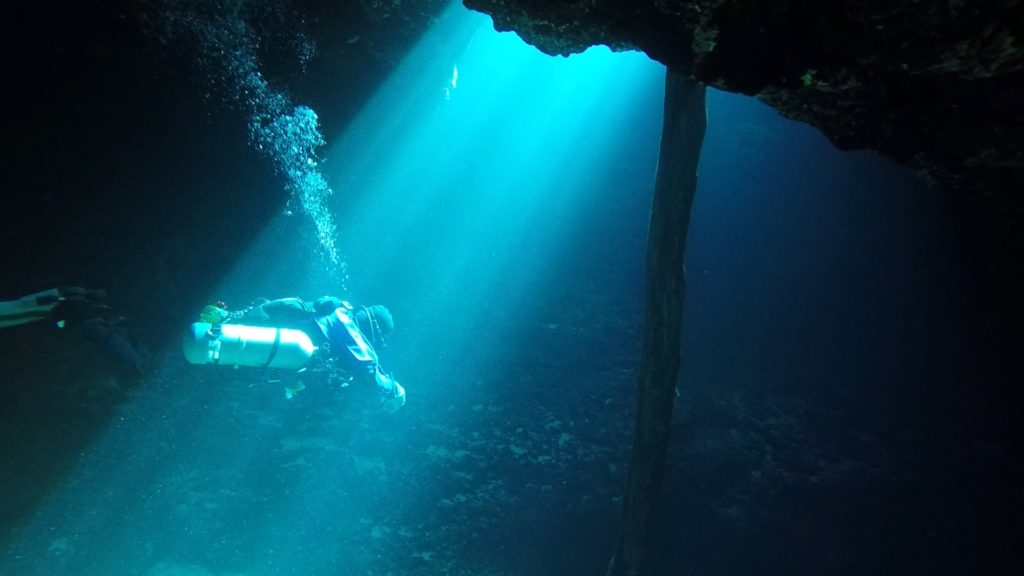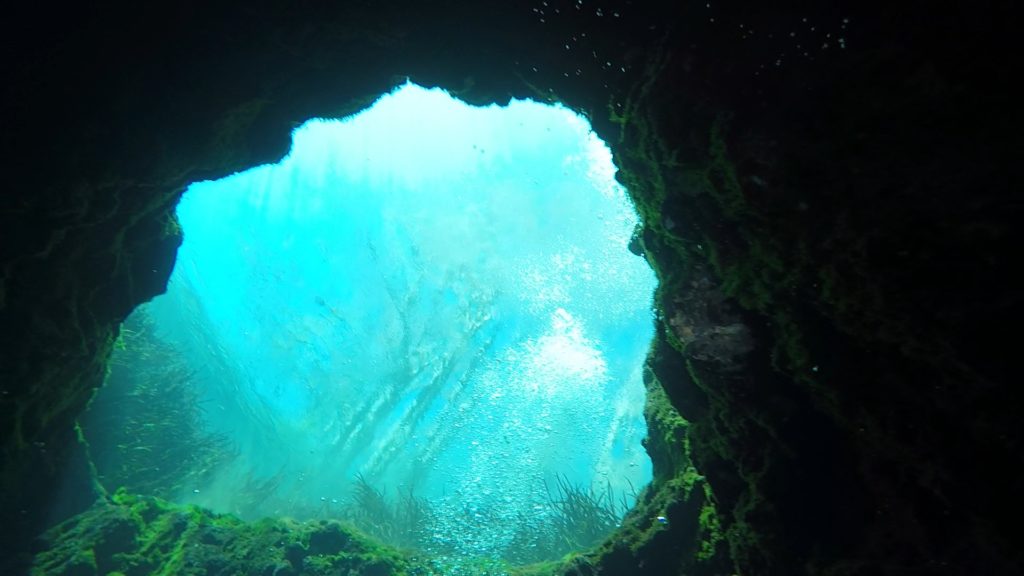
The Blue Hole
Diving Among Diamonds
Text and photos by Scott Jantz
| WE OFTEN JOKE that the walk down the quarter-mile boardwalk to Blue Hole is longer than the dive we are carting our gear to do. But what Ichetucknee’s Blue Hole spring lacks in length, she more than makes up for in beauty and challenge.
Cave divers use two styles of equipment, referred to as back-mount and side-mount. Since a diver cannot surface from a cave, all equipment must be redundant. So we carry (at least) two tanks either on our backs or under our arms. The under arm mount was originally invented to explore tight caves like Blue Hole where divers could not always fit with tanks on their backs. The style has become more popular recently due to the lesser strain on a diver’s knees and back from not having to carry the full weight down to the water and back out. What brought me to side-mount diving wasn’t bad knees or a back, but the beauty of Blue Hole.
The cavern zone at Blue Hole is the most spectacular of any of our springs. The entrance is a well-lit central hole (like the neck of the Jug, its other name) where a beam of light shines down into the first cavern room. This beam creates a natural sundial.
Formerly of Gainesville, Scott Jantz is an engineer, avid cave diver and enthusiastic paddler who now makes his home in the Tampa area.
I have swum and paddled the Ichetucknee for years. When I became cave certified, the iconic image that John Moran took in the cavern put Blue Hole on my list of places to see. Blue Hole is a series of large rooms separated by smaller spaces. The first two rooms are in what we refer to as the “cavern zone.” The words cave and cavern have very specific meanings in cave diving. A cavern is an area of a cave where visible light can still be seen. Although still riskier diving than pure open water, the cavern zone is open to divers with less training and equipment than the completely dark and maze-like cave zone. The cavern zone at Blue Hole is the most spectacular of any of our springs. The entrance is a well-lit central hole (like the neck of the Jug, its other name) where a beam of light shines down into the first cavern room. This beam creates a natural sundial. I can often just look at a picture and know what time of day it was taken. In the second room the beam can still be seen in the distance, but now with the surface obscured, the light here is a muted deep blue and the beam slowly moves with the tree shadows above. The effect is impossible to capture with any camera technology, but some good attempts have been made.

After the cavern zone, the cave enters an area called a bedding plane. A bedding plane is a very common geological feature in Florida. All our rocks are various combinations of fossils from millions of years of shallow seas that once covered Florida (and may again too soon). As the ecology changed the layers changed. Some are very crumbly and full of large fossils of mostly sea urchins and sea biscuits, plus some fish and whales. These layers are usually the ones the caves go though, the water better able to erode these softer rocks. The bedding plane is made of diatom (microscopic algae) bodies more slowly and thus result in very flat and hard layers, a plane that “beds” the lowest level of the cave. Many of our rivers also end in this layer. I have seen stretches so flat and white at the bottom of the Suwannee that it looks man-made, nearly indistinguishable from a concrete floor and made of the same material. The bedding plane in Blue Hole is very low but also very wide and, in side-mount gear, is actually comfortably traversable. Most images taken of divers in this area make it appear more claustrophobic than it feels.

Once the divers exit this section, the gray room awaits with its piles of diamond sands. The effect is magical. Anywhere our light beams fall on the floor, the sand sparkles as if full of diamonds. To my knowledge and based on various conversations I’ve had with other divers, these diamond sands exist nowhere else and their composition is unknown. At the end of this room is diamond sands restriction, requiring finesse to pass through a hole just large enough for a single diver. The cave continues in a main tunnel with tiny tunnels branching off, each bringing in water to the spring. At the end of this tunnel, the flow of water stops.

The loft room is the end of the cave for human-sized divers. Here the cave changes once again into a canyon with overhanging ledges and a thick silty bottom that requires care and training not to stir up. Obviously a large flow once carved this room, but silt has since filled it in. Was this natural or the result of human activity at the surface? Phosphate mines, lumber mills, and roads once existed at the surface not far from here. Who knows what lies buried at the end of Blue Hole Spring…perhaps tunnels leading north to Lake City and beyond.
